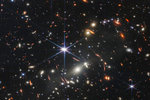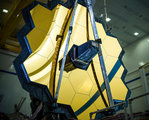


Our view of the universe just expanded: The first image from NASA’s new space telescope unveiled Monday is brimming with galaxies and offers the deepest look of the cosmos ever captured.
The first image from the $10 billion James Webb Space Telescope is the farthest humanity has ever seen, closer to the edge of the universe. That image will be followed Tuesday by the release of four more galactic beauty shots from the telescope’s initial outward gazes.
The “deep field" image released during a brief White House event is filled with lots of stars, with massive galaxies in the foreground and faint and extremely distant galaxies peeking through here and there.
The busy image with hundreds of specks, streaks, spirals, and swirls of white, yellow, orange, and red is only “one little speck of the universe,” NASA Administrator Bill Nelson said.
Sasselov said he and his colleague Charles Alcock first thought “we’ve seen this before." Then they looked closer at the image and pronounced the result not only beautiful but "worth all that waiting” for the much-delayed project.
And even more is coming Tuesday. The pictures on tap include a view of a giant gaseous planet outside our solar system, two images of a nebula where stars are born and die in spectacular beauty, and an update of a classic image of five tightly clustered galaxies that dance around each other.
The world’s biggest and most powerful space telescope rocketed away last December from French Guiana in South America. It reached its lookout point 1 million miles from Earth in January. Then the lengthy process began to align the mirrors, get the infrared detectors cold enough to operate, and calibrate the science instruments, all protected by a sunshade the size of a tennis court that keeps the telescope cool.
Webb is considered the successor to the highly successful, but aging Hubble Space Telescope.
At 21 feet, Webb’s gold-plated, flower-shaped mirror is the biggest and most sensitive ever sent into space. It’s comprised of 18 segments, one of which was smacked by a bigger than anticipated micrometeoroid in May. Four previous micrometeoroid strikes to the mirror were smaller. Despite the impacts, the telescope has continued to exceed mission requirements, with barely any data loss, according to NASA.
NASA is collaborating on Webb with the European and Canadian space agencies.